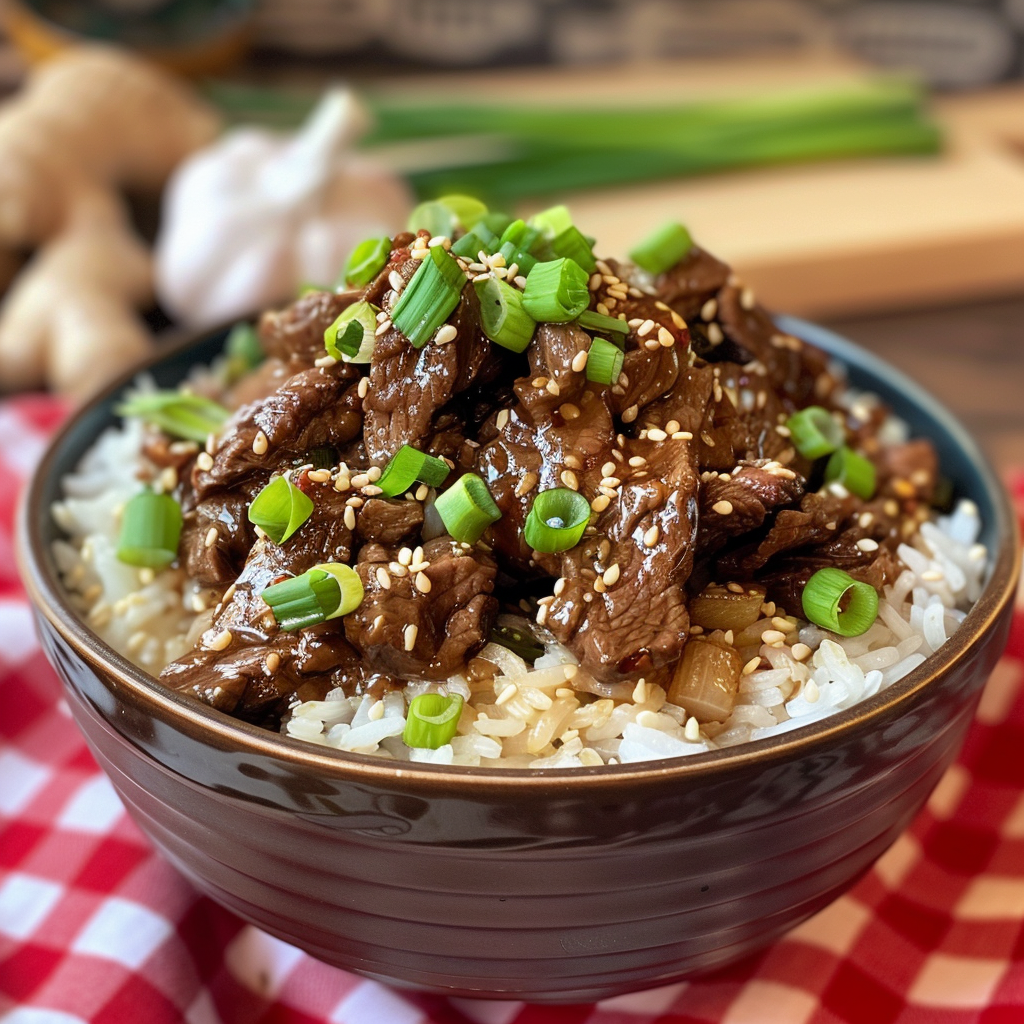Easy Korean Bulgogi Recipe: Authentic Flavors with Beef Sirloin or Rib-Eye

Share
This Dish Brings The Delicious Flavors of Korean Bulgogi To Your Table
This recipe for Korean Bulgogi is designed to bring vibrant flavors and satisfying textures to your table, with tips to ensure your success. Enjoy this delicious dish with the suggested pairings, and make every meal a special occasion! This dish is incredibly easy to make and perfect for those nights when you want something both flavorful and visually appealing. If you’re looking to create a colorful, simple menu, consider pairing this Korean Bulgogi with a side of steamed broccoli or sautéed bok choy, and perhaps some pickled vegetables like kimchi or radishes for a tangy contrast. The key to making this dish truly shine is allowing time for the beef to marinate—this is what deepens the flavors and makes the meat tender and juicy. Trust me, the extra time you spend marinating will be well worth it when you take that first bite. Plus, the aroma that fills your kitchen as the beef cooks is nothing short of mouthwatering. So, whether you’re cooking for a casual family dinner or entertaining guests, this dish is sure to impress without requiring a lot of fuss.
Did You Know?
Bulgogi, which means "fire meat" in Korean, is a traditional dish that has been enjoyed for centuries. It was originally prepared with thin slices of beef marinated in a mixture of soy sauce, sugar, sesame oil, garlic, and other ingredients, then grilled over an open flame. Today, bulgogi can be cooked on a stovetop, in a pan, or even in a slow cooker, making it a versatile and beloved dish both in Korea and around the world.
Yield: 4 servings
Ingredients:
1 pound beef sirloin or rib-eye, thinly sliced
1/4 cup soy sauce
2 tablespoons brown sugar
2 tablespoons sesame oil
1 tablespoon grated ginger
3 cloves garlic, minced
1/2 pear, grated (optional for tenderness)
1 tablespoon rice vinegar
1 tablespoon gochujang (Korean chili paste) or 1 teaspoon red pepper flakes (optional for spice)
4 cups cooked white rice
1 tablespoon vegetable oil
1/4 cup chopped green onions
Sesame seeds for garnish
Instructions:
Marinate the Beef:
In a bowl, combine soy sauce, brown sugar, sesame oil, grated ginger, minced garlic, grated pear, rice vinegar, and gochujang (if using). Add the sliced beef and mix well to ensure the beef is fully coated. Cover and refrigerate for at least 30 minutes, or up to overnight for more intense flavor.
Personal Tip: For best results, slice the beef as thinly as possible. Freezing the meat for 20 minutes before slicing can make this easier and ensure even marination.
Cook the Beef:
Heat the vegetable oil in a large skillet over medium-high heat. Add the marinated beef to the skillet and cook for about 5-7 minutes, or until the beef is fully cooked and caramelized, stirring occasionally.
Personal Tip: To achieve that perfect caramelization, avoid overcrowding the pan. Cook the beef in batches if necessary, giving each piece room to brown properly.
Prepare the Rice:
While the beef is cooking, ensure your rice is cooked and ready to serve.
Personal Tip: If you want fluffier rice, rinse it under cold water until the water runs clear before cooking. This removes excess starch and prevents the rice from becoming sticky.
Combine and Serve:
Divide the cooked rice into four bowls. Top with the cooked beef and garnish with chopped green onions and sesame seeds. Serve immediately.
Personal Tip: For added flavor, drizzle a little extra sesame oil over the finished dish just before serving. This enhances the richness and complements the beef perfectly.
Nutritional Information (Per Serving):
Calories: 500, Protein: 25g, Carbohydrates: 50g, Sugars: 12g, Total Fat: 20g, Saturated Fat: 5g, Sodium: 1000mg, Fiber: 2g
Kitchen Tips, Great Ideas, How to Save Money
- Beef Selection: Look for sales on beef sirloin or rib-eye. You can also use cheaper cuts of beef, like flank steak, and marinate them longer to achieve tenderness.
- Marinating Time: Marinating the beef overnight will enhance the flavor and make the meat more tender. If you're short on time, even 30 minutes will make a difference.
- Vegetable Additions: Add sliced onions, bell peppers, or mushrooms to the beef while cooking for extra flavor and nutrition.
- Rice Options: Use brown rice or quinoa as a healthier alternative to white rice. These grains add extra fiber and nutrients to the meal.
- Leftovers: Store any leftovers in an airtight container in the refrigerator for up to 3 days. Reheat in a skillet or microwave before serving.
- Meal Prep: Prepare the marinade and slice the beef ahead of time. This makes it easy to cook the dish quickly on a busy night.
- Cost-Saving: Buy ingredients like soy sauce, sesame oil, and rice in bulk to save money. These pantry staples have a long shelf life.
- Spice Level: Adjust the amount of gochujang or red pepper flakes to your taste preference. For a milder dish, omit these ingredients.
- Garnishing: Fresh green onions and sesame seeds add a nice crunch and flavor. You can also garnish with shredded carrots or thinly sliced radishes for added color and texture.
- Serving Suggestions: Serve this dish with a side of kimchi or pickled vegetables to complement the flavors. You can also add a simple salad of mixed greens with a light sesame dressing.
Let's Learn About Sirloin and Rib-Eye
When it comes to making a dish like bulgogi, choosing the right cut of beef is crucial. Sirloin and rib-eye are two popular options, each offering unique qualities. Sirloin is a leaner cut with a more robust, beefy flavor, making it ideal for those who prefer a less fatty meat. It's also slightly more affordable than rib-eye, making it a great option for everyday meals. Rib-eye, on the other hand, is known for its rich marbling, which adds to its tenderness and juiciness. The fat content in rib-eye melts during cooking, infusing the meat with a buttery flavor that is hard to beat. When preparing bulgogi, either cut works wonderfully, but your choice will depend on your preference for lean or rich meat. No matter which cut you choose, slicing the meat thinly and allowing ample time for marination are key steps to achieving that signature bulgogi flavor and texture.


